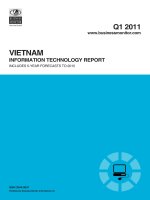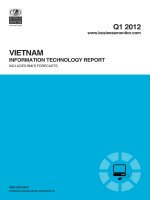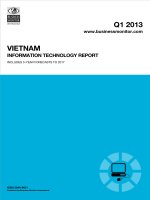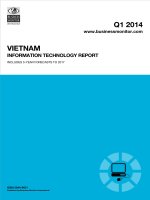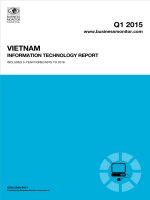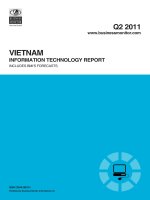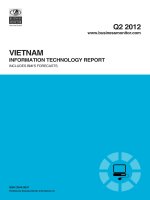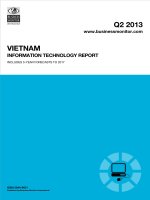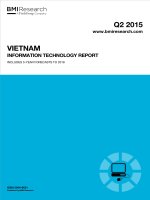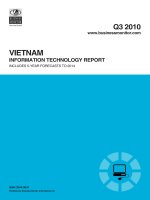Vietnam information technology report q3 2014
Bạn đang xem bản rút gọn của tài liệu. Xem và tải ngay bản đầy đủ của tài liệu tại đây (509.29 KB, 85 trang )
Q3 2014
www.businessmonitor.com
VIETNAM
INFORMATION TECHNOLOGY REPORT
INCLUDES 5-YEAR FORECASTS TO 2018
ISSN 2044-9631
Published by:Business Monitor International
Vietnam Information Technology
Report Q3 2014
INCLUDES 5-YEAR FORECASTS TO 2018
Part of BMI’s Industry Report & Forecasts Series
Published by: Business Monitor International
Copy deadline: June 2014
Business Monitor International
Senator House
85 Queen Victoria Street
London
EC4V 4AB
United Kingdom
Tel: +44 (0) 20 7248 0468
Fax: +44 (0) 20 7248 0467
Email:
Web:
© 2014 Business Monitor International
All rights reserved.
All information contained in this publication is
copyrighted in the name of Business Monitor
International, and as such no part of this
publication may be reproduced, repackaged,
redistributed, resold in whole or in any part, or used
in any form or by any means graphic, electronic or
mechanical, including photocopying, recording,
taping, or by information storage or retrieval, or by
any other means, without the express written consent
of the publisher.
DISCLAIMER
All information contained in this publication has been researched and compiled from sources believed to be accurate and reliable at the time of
publishing. However, in view of the natural scope for human and/or mechanical error, either at source or during production, Business Monitor
International accepts no liability whatsoever for any loss or damage resulting from errors, inaccuracies or omissions affecting any part of the
publication. All information is provided without warranty, and Business Monitor International makes no representation of warranty of any kind as
to the accuracy or completeness of any information hereto contained.
CONTENTS
BMI Industry View 7
SWOT 9
IT SWOT 9
Wireline 11
Political 13
Economic 14
Business Environment 15
Industry Forecast 16
Table: IT Industry - Historical Data And Forecasts (Vietnam 2011-2018) 16
Macroeconomic Forecasts 22
Economic Analysis 22
Table: Foreign Direct Investment By Country Of Origin (Top Five) 26
Table: Vietnam - Economic Activity 27
Industry Risk Reward Ratings 28
Table: Asia-Pacific Risk/Reward Ratings - Q3 2014 30
Market Overview 31
Hardware 31
Software 36
Services 45
Industry Trends And Developments 51
Regulatory Development 56
Table: Government Authority 56
Regulatory News 59
Competitive Landscape 62
International Companies 62
Table: Samsung Electronics 62
Table: Intel 63
Table: LG Electronics 64
Table: Global CyberSoft 65
Local Companies 66
Table: Sara Vietnam 66
Company Profile 67
FPT Software 67
Table: FPT Group Revenue By Segment (VNDbn) 70
Vietnam Information Technology Report Q3 2014
© Business Monitor International Page 4
Regional Overview 72
Demographic Forecast 76
Table: Vietnam's Population By Age Group, 1990-2020 ('000) 77
Table: Vietnam's Population By Age Group, 1990-2020 (% of total) 78
Table: Vietnam's Key Population Ratios, 1990-2020 79
Table: Vietnam's Rural And Urban Population, 1990-2020 79
Methodology 80
Industry Forecast Methodology 80
Sources 81
Risk/Reward Ratings Methodology 82
Table: It Risk/Reward Ratings Indicators 83
Table: Weighting Of Components 84
Vietnam Information Technology Report Q3 2014
© Business Monitor International Page 5
BMI Industry View
BMI View: We forecast IT spending will grow at a compound annual growth rate (CAGR) of 12.6%
between 2014 and 2018, with expansion underpinned by rising incomes, enterprise modernisation and the
policy environment put in place by the government. We also highlight larger opportunities in the retail
market where penetration of devices and services remains below the level in neighbouring markets, which
vendors will be able to tap as incomes rise. The government is also a significant factor underpinning our
bright outlook as it pursues a range of ICT initiatives and allocates funding to develop Vietnam's domestic
IT industry. These policies include the promotion of Vietnam as an outsourcing destination, with the
services segment expected to expand rapidly. There is also increasing momentum towards Vietnam
becoming a global centre for electronics production as wages rise in China and manufacturers look to
protect margins by moving to Vietnam, where wages are as little as a third of those in China.
Headline Expenditure Projections
■
Computer Hardware Sales: VND38.2trn in 2014 to VND57.3trn in 2018, CAGR of +10.7% in local
currency terms. Rising incomes, declining device prices and improved credit provision underpin demand
growth across all three main device categories.
■
Software Sales: VND8.4trn in 2014 to VND14.6trn in 2018, CAGR of +15.0% in local currency terms.
Piracy continues to be a drag on the market, but there are large opportunities in business software and
security solutions for vendors willing to accept narrow margins in a price-sensitive market.
■
IT Services Sales: VND16.5trn in 2013 to VND29.4trn in 2018, CAGR of +15.7% in local currency
terms. The services segment is forecast to outperform due to strong domestic demand for cloud
computing, and a boom in investment for outsourcing provision to Japanese enterprises.
Key Trends & Developments
One opportunity that stands out in Vietnam is for tailored solutions for the agricultural sector, which
continues to be a large part of the Vietnamese economy accounting for an estimate 19.5% share of GVA in
2013 - a figure BMI expects to only decrease marginally to 19.3% in 2018 - and its share of labour is
considerably higher. The large agricultural sector, and the potential for productivity increases, has
understandably attracted the interest of ICT firms. Mobile operator Viettel is a world leader in pioneering
smart agricultural products, including IT services such as information packages about produce prices,
disease warning, weather reports and analysis of coffee and cashew nut markets. These products generated
VND7bn a month in revenue - a far higher figure than that generated from the much hyped game
application development market. The success of Viettel's model has attracted interest from IT services
providers, for instance Hanel has stated its intention to develop smart agriculture products.
Vietnam Information Technology Report Q3 2014
© Business Monitor International Page 7
Another area of emerging opportunity is the cloud computing market in Vietnam. In June 2014 VMWare
reported the results of its cloud adoption survey in Vietnam. It found that 80% of polled businesses
considered cloud computing the number one priority for IT applications; while 67% were confident cloud
computing would have a major effect on business activities. The large quantities of data generated by the
surge in featurephone and smartphone ownership have boosted demand for enterprise cloud solutions, while
the growing tendency for remote working is also generating demand. VMWare estimates that cloud
adoption is growing faster in Vietnam than the wider region as a result of an absence of legacy on-premises
systems due to Vietnam's late-developer status. While the survey showed growing interest, information
security continues to be a barrier to adoption by enterprises. VMWare and Symantec were both quoted
arguing that education levels must increase among enterprises so they realise the comparability of
information security risks for cloud and on-premises IT solutions.
Vietnam Information Technology Report Q3 2014
© Business Monitor International Page 8
SWOT
IT SWOT
SWOT Analysis
Strengths
■
Supportive policy framework and funding in place to promote the development of the
IT sector.
■
Vietnam's gradual integration into the global trade network via its accession into trade
organisations such as ASEAN and WTO, as well as bilateral agreements with Japan
and China.
■
The domestic IT market is in a rapid growth phase, with trade liberalisation and
growing affordability driving increased adoption among enterprises and consumers.
■
Expanding local hardware production industry with major international players such
as Samsung, Nokia, LG and Intel making large investments.
Weaknesses
■
IT spend per capita is much lower than in neighbouring Thailand, reflecting a much
lower GDP per capita.
■
Highly cost-sensitive market, with 75% of software provided by lower-cost local
software vendors.
■
High level of software piracy, although some progress has been made in recent years.
Opportunities
■
Low PC penetration means there is scope for vendors to tap first-time buyer market
as well as the upgrade/replacement market. Due to low penetration desktop and
notebook sales continue to increase despite competition from tablets.
■
Low-cost tablets are proving popular with consumers, with significant medium-term
sales growth potential as incomes continue to rise.
■
Vietnam is a popular destination for software development and IT services
outsourcing, with particularly strong growth potential from Japanese enterprises that
are turning away from Chinese based providers.
Vietnam Information Technology Report Q3 2014
© Business Monitor International Page 9
SWOT Analysis - Continued
■
National IT Plan will drive spending on IT utilisation in areas such as e-government, e-
taxation and education.
■
SMEs have much potential to increase spending on basic solutions, including
customer relationship management and security.
■
The government's drive to create an IT services industry over the next 15-20 years -
through incentives to create IT clusters - is expected to be a significant factor shaping
the market.
■
Cloud computing awareness has risen fast and adoption is expected to accelerate
through 2014 and 2015.
Threats
■
Low-cost tablets from own-brand Chinese vendors a particular threat to low- and
mid-range notebook vendors. Falling prices may further undermine margins and
profitability after steep discounting.
■
Cyber security issues could undermine confidence in IT solutions and services, with
big data and cloud computing vulnerable.
■
Yen depreciation has hit the software outsourcing market by making exports less
competitive and eroding Vietnam's cost advantages.
Vietnam Information Technology Report Q3 2014
© Business Monitor International Page 10
Wireline
SWOT
Strengths
■
Fixed-line penetration levels and internet user rates are high in major urban centres
such as Ho Chi Minh City, Hanoi, Danang and Haiphong.
■
Competition exists in fixed-line and internet access markets; VNPT faces competition
from several other state-owned companies and privately owned operators.
■
High levels of literacy and other demographic factors bode well for strong and
continued demand for wireline services over the next few years.
Weaknesses
■
Vietnam's fixed-line and internet access markets are dominated by state-controlled
operator VNPT.
■
Although alternative broadband infrastructures are currently being explored,
broadband growth continues to be highly dependent on DSL.
■
Low fixed-line penetration rates in rural regions limit the scope for DSL broadband
growth.
■
Although internet user growth is improving, rural Vietnam still has limited access to
internet infrastructure.
■
Broadband tariffs remain high, creating a barrier for low-income subscribers to
access.
Opportunities
■
The privatisation of VNPT could help to bring about increased investment revenue
and the arrival of new skills.
■
On a national level, broadband penetration rates remain low - this means that the
sector has considerable growth potential.
■
Significant opportunities exist to develop alternative broadband technologies,
including WiMAX, LTE and fibre; WiMAX and LTE internet services have the potential
to raise the level of internet user penetration in rural parts of Vietnam.
Vietnam Information Technology Report Q3 2014
© Business Monitor International Page 11
SWOT - Continued
■
Draft Bill of Law on Telecommunication has been put forward for discussion at the
National Assembly Steering Committee. If passed, the bill will allow private
companies to build network infrastructure for the first time and will open up the
telecoms market to foreign investors.
Threats
■
Fixed-line sector may enter a period of decline, with potentially negative
consequences for DSL growth.
■
As the market for mobile data services grows, this could have potentially negative
consequences for the growth of fixed broadband services.
■
VTV's dominance in the pay-TV sector is holding back market development.
Vietnam Information Technology Report Q3 2014
© Business Monitor International Page 12
Political
SWOT Analysis
Strengths
■
The Communist Party of Vietnam remains committed to market-oriented reforms and
we do not expect major shifts in policy direction over the next five years. The one-
party system is generally conducive to short-term political stability.
■
Relations with the US have witnessed a marked improvement, and Washington sees
Hanoi as a potential geopolitical ally in South East Asia.
Weaknesses
■
Corruption among government officials poses a major threat to the legitimacy of the
ruling Communist Party.
■
There is increasing (albeit still limited) public dissatisfaction with the leadership's tight
control over political dissent.
Opportunities
■
The government recognises the threat corruption poses to its legitimacy, and has
acted to clamp down on graft among party officials.
■
Vietnam has allowed legislators to become more vocal in criticising government
policies. This is opening up opportunities for more checks and balances within the
one-party system.
Threats
■
Macroeconomic instabilities continue to weigh on public acceptance of the one-party
system, and street demonstrations to protest economic conditions could develop into
a full-on challenge of undemocractic rule.
■
Although strong domestic control will ensure little change to Vietnam's political scene
in the next few years, over the longer term, the one-party-state will probably be
unsustainable.
■
Relations with China have deteriorated over recent years due to Beijing's more
assertive stance over disputed islands in the South China Sea and domestic criticism
of a large Chinese investment into a bauxite mining project in the central highlands,
which could potentially cause wide-scale environmental damage.
Vietnam Information Technology Report Q3 2014
© Business Monitor International Page 13
Economic
SWOT Analysis
Strengths
■
Vietnam has been one of the fastest-growing economies in Asia in recent years, with
GDP growth averaging 7.1% annually between 2000 and 2012.
■
The economic boom has lifted many Vietnamese out of poverty, with the official
poverty rate in the country falling from 58% in 1993 to 20.7% in 2012.
Weaknesses
■
Vietnam still suffers from substantial trade and fiscal deficits, leaving the economy
vulnerable to global economic uncertainties. The fiscal deficit is dominated by
substantial spending on social subsidies that could be difficult to withdraw.
■
The heavily-managed and weak currency reduces incentives to improve quality of
exports, and also keeps import costs high, contributing to inflationary pressures.
Opportunities
■
WTO membership and the upcoming ASEAN AEC in 2015 should give Vietnam
greater access to both foreign markets and capital, while making Vietnamese
enterprises stronger through increased competition.
■
The government will in spite of the current macroeconomic woes, continue to move
forward with market reforms, including privatisation of state-owned enterprises, and
liberalising the banking sector.
■
Urbanisation will continue to be a long-term growth driver. The UN forecasts the
urban population rising from 29% of the population to more than 50% by the early
2040s.
Threats
■
Inflation and deficit concerns have caused some investors to re-assess their hitherto
upbeat view of Vietnam. If the government focuses too much on stimulating growth
and fails to root out inflationary pressure, it risks prolonging macroeconomic
instability, which could lead to a potential crisis.
■
Prolonged macroeconomic instability could prompt the authorities to put reforms on
hold as they struggle to stabilise the economy.
Vietnam Information Technology Report Q3 2014
© Business Monitor International Page 14
Business Environment
SWOT Analysis
Strengths
■
Vietnam has a large, skilled and low-cost workforce, which has made the country
attractive to foreign investors.
■
Vietnam's location - its proximity to China and South East Asia, and its good sea links
- makes it a good base for foreign companies to export to the rest of Asia, and
beyond.
Weaknesses
■
Vietnam's infrastructure is still weak. Roads, railways and ports are inadequate to
cope with the country's economic growth and links with the outside world.
■
Vietnam remains one of the world's most corrupt countries. According to
Transparency International's 2012 Corruption Perceptions Index, Vietnam ranks 123
out of 176 countries.
Opportunities
■
Vietnam is increasingly attracting investment from key Asian economies, such as
Japan, South Korea and Taiwan. This offers the possibility of the transfer of high-tech
skills and know-how.
■
Vietnam is pressing ahead with the privatisation of state-owned enterprises and the
liberalisation of the banking sector. This should offer foreign investors new entry
points.
Threats
■
Ongoing trade disputes with the US, and the general threat of American
protectionism, which will remain a concern.
■
Labour unrest remains a lingering threat. A failure by the authorities to boost skills
levels could leave Vietnam a second-rate economy for an indefinite period.
Vietnam Information Technology Report Q3 2014
© Business Monitor International Page 15
Industry Forecast
Table: IT Industry - Historical Data And Forecasts (Vietnam 2011-2018)
2011 2012 2013e 2014f 2015f 2016f 2017f 2018f
IT market
value,
VNDmn
40,863,664 47,495,837 55,874,102 63,193,610 71,092,811 80,242,456 90,304,860 101,331,083
IT market
value, % of
GDP
1.5 1.5 1.6 1.6 1.6 1.6 1.6 1.6
Computer
hardware
sales,
VNDmn
25,948,427 29,684,898 34,362,573 38,232,134 42,300,223 46,941,837 51,925,294 57,252,062
Personal
computer
sales,
VNDmn
21,070,123 24,341,616 28,452,210 31,656,207 35,109,185 38,961,724 43,097,994 47,519,212
Software
sales,
VNDmn
5,115,354 6,066,949 7,284,224 8,409,779 9,659,520 11,133,490 12,789,361 14,642,386
Services
sales,
VNDmn
9,799,883 11,743,990 14,227,305 16,551,697 19,133,069 22,167,129 25,590,204 29,436,635
e/f - BMI estimate/forecast. Source: BMI.
BMI has a positive outlook for ongoing IT market expansion and we believe it will be one of the
outperforming IT markets in APAC over the medium term. The market is relatively undeveloped but the IT
sector will account for a growing share of GDP over the duration of our five-year forecast to 2018 as a
result of a range of factor including supportive government policy, rising incomes, declining device prices,
enterprise modernisation and investments in telecoms infrastructure. Meanwhile, Vietnam's software
development and outsourcing services firms are positioned to benefit from large foreign enterprises seeking
lower cost locations over the medium term.
We forecast the IT market in Vietnam will expand by 13.1% to a total of VND63.2trn in 2014, up from
VND55.9trn in 2013. We expect strong growth to continue over the medium, term with a CAGR of 12.6%
2014-2018, as the value of the market is set to reach VND101.3trn in 2018.
Vietnam Information Technology Report Q3 2014
© Business Monitor International Page 16
2014 Outlook
Our outlook for 2014 is unchanged in the Q3 2014
update, as we continue to forecast another year of
strong growth for Vietnam's IT market in 2014.
Growth is expected to slow slightly from 2013 as a
result of a slight cooling of the tablet market, but the
market is still expected to expand by 13.1%.
The first feature of the market underpinning our
positive outlook is the strong macroeconomic
environment in Vietnam. We forecast real GDP
growth of 5.9% in 2014 and real growth of private
final consumption of 6.5%. Meanwhile, traditional
areas of weakness, such as access to credit, have
become a less significant factor as a result of
partnerships between banks and retailers formed in
2013. Meanwhile, government spending will
continue to be a major source of sales, with spending
forecast to increase by 6.2% in real terms in 2014, and we expect IT spending growth to outpace overall
government spending due to the policy goal of developing the sector. This is evidenced by the Ministry of
Information and Communication's August 2013 proposal to allocate at least 2% of the state budget to
boosting the IT sector each year.
In contrast to developed markets where the retail PC market is a drag on growth, in Vietnam it will continue
to be a bright spot throughout 2014. We expect growth in desktop, notebook and tablet shipments as rising
incomes and declining device prices - as well as improved access to credit - promote first-time buyer and
upgrade sales. The influx of low-priced Chinese own-brand tablets since 2012 has deepened the market and
vendors in the notebook category have been lowering prices to compete with this influx, which has helped
make devices more affordable and boosted sales. There is evidence in H114 that hybrid notebooks have
carved out a significant niche and are beginning to challenge tablets by offering multi-use cases, a more
important development in emerging markets where consumers are focused on value for money more than
the fashion cache of tablets.
Industry Trends - IT Market
2011-2018
e/f - BMI estimate/forecast. Source: BMI.
Vietnam Information Technology Report Q3 2014
© Business Monitor International Page 17
Meanwhile, government spending and PC subsidy programmes will continue to be supportive of the PC
market in 2014 as the government continues to roll out IT modernisation programmes. The government has
been spending heavily on IT, with around 50% of this going to hardware in recent years. It has also spent
heavily on licensing software used by government agencies, but in 2013 the Ho Chi Minh City government
began a push to increase the utilisation of open-source software, which could be replicated elsewhere.
However, in early 2014 it was reported that the government was abandoning part of its open source
implementation project due to a shortage of technical maintenance staff in the country.
In terms of the enterprise sector in Vietnam, the outsourcing market continues to develop rapidly, although
the outlook for 2014 is weaker than previous years. Vietnam has become the first choice for Japanese
enterprises looking to outsource functions in recent years, primarily based on the cost advantages offered.
However, the depreciation of the yen against the US dollar has hit the competitiveness of Vietnamese
providers, and will be a drag on expansion. This weakens the outlook, but with a well developed
outsourcing industry in Vietnam and several clusters, and underlying cost advantages, BMI expects demand
will continue to expand.
Drivers
An emerging area in the Vietnam IT market that we
expect to make a significant contribution to medium
term growth is the cloud computing market. In June
2014 VMWare reported the results of its cloud
adoption survey in Vietnam. It found that 80% of
polled businesses considered cloud computing the
number one priority for IT applications; while 67%
were confident cloud computing would have a major
effect on business activities. VMWare estimates that
cloud adoption is growing faster in Vietnam than the
wider region as a result of an absence of legacy on-
premises systems due to Vietnam's late-developer
status. The existing drag on the market, that is
concerns about information security, should lessen
as cloud education levels increase, and drive growth
higher.
Income Per Capita Breakdown
(2011-2018)
Poorest 20%, net income per capita, VND
Richest 20%, net income per capita, VND
Middle 60% of population, net income per capita, VND
2011 2012 2013e 2014f 2015f 2016f 2017f 2018f
0
25,000,000
50,000,000
75,000,000
100,000,000
e/f - BMI estimate/forecast. Source: BMI, National
Statistics Office
Vietnam Information Technology Report Q3 2014
© Business Monitor International Page 18
The government is a major supporter of the development of the IT market in Vietnam through policy
initiatives and financing. Policies include promoting the use of IT by government agencies, citizens and
enterprises - as well as promoting the development of local industry, particularly in software and
outsourcing services.
For instance, in November 2014 the government announced it would spend USD400,000 on building its
own version of California's Silicon Valley for start-ups, with two accelerators set up in Hanoi and Ho Chi
Minh city. The government hopes the development will help mature emerging technology companies in the
country and link them with suitable venture capital. A number of government ministries and organisations,
including the Ministry of Education and Training, have also started to promote the roll-out of cloud
services. The government has also promoted the IT industry through policy and incentives to grow hi-tech
parks, both for the construction of IT hardware, but increasingly software and IT services.
A specific IT development initiative is the government's drive to grow the IT services industry over the next
15-20 years. The cost of outsourcing in Vietnam was estimated in 2013 research to be as much as 30%
lower than in China, a fact which Japanese firms were especially aware of. The momentum that could be
garnered from Japanese enterprises shifting business process and software development outsourcing to
Vietnam could see medium term increases from European and North American demand.
However, growth will depend on government progress on various business environment issues, including
copyright protection and combating cyber security threats. Further progress in combating software piracy,
which is still reported to be at higher levels than in China, India and Thailand, despite some progress in
recent years, is required. It is also taking steps to increase the penetration of information security
certification by distributing funds to enterprises. In August 2013 it was reported that the government was
investing USD42mn in the creation of the National Centre for Network Security Technology. The
government is also updating the Law on Information Security, which closed for public comment in July
2013, as it looks to improve the cyber security environment including combating attacks originating in
Vietnam.
Improvements to supporting infrastructure are also driving IT market development. Telecoms operators are
investing in the expansion of both wireline and wireless broadband network infrastructure to rural areas, as
well as upgrading capacity of urban infrastructure and improving backbone networks. Additionally,
telecoms operators such as Viettel are emerging as significant distribution channels for notebooks as
vendors seek tie-ups. In a country where PC penetration remains low, particularly in rural areas,
Vietnam Information Technology Report Q3 2014
© Business Monitor International Page 19
government digital divide programmes to boost internet and digital utility in rural areas underpin
addressable market growth and open PC ownership to a growing number of rural inhabitants.
Segments
The agricultural sector continues to be a large part of
the Vietnamese economy accounting for an estimate
19.5% share of GVA in 2013 - a figure BMI expects
to only decrease marginally to 19.3% in 2018 - and
its share of labour is considerably higher. The large
agricultural sector, and the potential for productivity
increases, has understandably attracted the interest of
ICT firms.
Mobile operator Viettel is a world leader in
pioneering smart agricultural products, including IT
services such as information packages about produce
prices, disease warning, weather reports and analysis
of coffee and cashew nut markets. These products
generated VND7bn a month in revenue - a far higher
figure than that generated from the much hyped
game application development market. The success
of Viettel's model has attracted interest from IT
services providers, for instance Hanel has stated its intention to develop smart agriculture products. BMI
expects the agriculture vertical in Vietnam has medium term growth potential as vendors innovate real-time
updates for producers.
Large Vietnamese companies are the most likely to buy packaged software from multinationals, which have
only around 25% of the local software market. In the large corporate sector, growing demand for digital
infrastructure projects in segments such as banking, telecoms and energy has attracted global IT services
leaders, such as IBM, to invest in Vietnam. Foreign investment, particularly by Japanese companies, in call
centres and other areas will help to grow the market.
Smaller enterprises have a lower penetration of enterprise software, including ERP and security software,
but due to price sensitivity favour local solutions. The SME market is an area of the market in which
vendors can achieve growth as SME awareness of the benefits of IT utilisation increase, encouraged by
GVA By Vertical (%)
2014f
f - BMI forecast. Source: BMI, National Statistics, World
Bank, UN
Vietnam Information Technology Report Q3 2014
© Business Monitor International Page 20
government initiatives to modernise firms and improve international competitiveness. However, vendors
will have to face the challenge of enterprises that are constrained by low budgets and lack of access to
credit. Promising SME verticals include discrete manufacturing and consumer packaged goods, as well as
hotels and property management. The solution areas with most demand currently include security software
and key applications such as CRM, ERP and HR management.
Finally, the government is a major source of demand for IT vendors, across the hardware, software and
services segments. In April 2013 the Ho-Chi Minh City authority announced plans to spend VND300bn
(USD14.3mn) on developing e-government capacity. It will also focus on replacing out of date hardware
and improving network security in 2013. An additional feature is the authority's intention to work with local
small and medium IT enterprises where possible, rather than immediately turning to large IT vendors.
Spending in 2013 was a marked increase over the 2005-2012 period when the city authority carried out
1,012 projects with a total spend of VND665bn.
Summary
Overall, the hardware market is anticipated to grow from VND38.2trn in 2014 to VND57.3trn in 2018, with
computer sales rising from VND31.56trn to VND47.5trn over the same period. Software spending should
rise from VND8.trn to VND14.6trn and IT services from VND16.5trn to VND29.4trn over the forecast
period.
Vietnam Information Technology Report Q3 2014
© Business Monitor International Page 21
Macroeconomic Forecasts
Economic Analysis
BMI View: Latest GDP figures show that the Vietnamese economy grew by 5.0% y-o-y in Q114, and we
believe that our 2014 real GDP growth forecast of 5.9% remains in sight. Indeed, we believe that increased
macroeconomic stability, combined with pro-growth policies will help the economy accelerate from 2013
levels. Key downside risks to this view include a faster-than-anticipated slowdown in China as well as the
stalling of the country's reform drive.
Latest data released by the General Statistics office of Vietnam (GSO) showed that real GDP accelerated by
5.0% year-on-year (y-o-y) in Q114, slightly faster than the 4.9% print registered in the Q113. Although it
showed a deceleration from 6.0% recorded in Q413, we believe that the economy is still on track to hit our
2014 growth forecast of 5.9% in 2014. This would mark a slight acceleration from the 5.4% registered in
2013, and is above estimates by the Asian Development Bank, which forecasts real GDP to reach 5.6% in
2014. We believe that the economy will be driven by a strengthening of private consumption, continued
foreign direct investment into key areas of the economy, a more robust external sector, and a rebound in
manufacturing activity over the coming quarters. That said, trend growth for the Vietnamese economy will
average a slower 6.2% over the next decade, compared to 6.5% recorded in the past 10 years.
Vietnam Information Technology Report Q3 2014
© Business Monitor International Page 22
Still-Strong Growth
Vietnam - Real GDP Growth, (% chg y-o-y)
Source: GSO, BMI
A breakdown of the data show that all sectors of the economy witnessed an acceleration in growth over the
quarter: agriculture, forestry and fisheries, which accounts for approximately 13% of GDP grew by 2.4% y-
o-y in Q114, while the industrial and construction sectors, which account for 40% of GDP expanded by
4.7% y-o-y. Importantly, the services sector which accounts for the lion's share of the economy at 47% of
GDP, accelerated by a stellar 6.0% in Q114, contributing a whopping 2.8 percentage points of the overall
growth figure. Going forward, we expect that the manufacturing, construction and service sectors will
continue to do well on the back of policy driven efforts to stimulate growth.
Vietnam Information Technology Report Q3 2014
© Business Monitor International Page 23
Services Taking The Lead
Vietnam - Breakdown of GDP By Component (% chg y-o-y) & Share % (RHS)
Source: GSO, BMI
Government Policy To Ensure Growth Remains Strong
We believe that government policies aimed at promoting balanced economic growth, improving the stability
of the banking system, diversifying exports, attracting foreign investment and attracting investment in
infrastructure bode well for the economic outlook. In terms of promoting balanced growth, we note that the
State Bank of Vietnam (SBV) has continued to rein in inflation, which, at 4.8% y-o-y in the first quarter,
remains near record lows and well below the central bank's target of around 7.0%. The slight deceleration in
economic activity in Q114, combined with the weak inflation data over the period prompted the SBV to cut
its refinancing rate from 7.0% to 6.5% in March. Although we do not expect further cuts this year (see:
Downside Risks To Interest Rate Forecast, March 21), the central bank has adopted a dovish tone, and
could step in again should it feel that the economy needs more stimulus. With regard to banking sector
reform, the SBV continues to push forward with reforms aimed at improving the stability of the sector and
increasing credit to the economy. Two key policies are the reduction in non-performing loans, which
according to Moody's, stands at approximately 15%, as well as offloading bad debt off of bank's balance
sheets and on to the newly created Vietnam Asset Management Company (VAMC). By the end of 2013 the
VAMC had purchased approximately US$1.9bn worth of bad debt, and it aims to increase the pace of
purchases over the coming months. Combined, these policies should help stimulate credit growth over the
coming quarters, which will help underpin broader economic activity.
Vietnam Information Technology Report Q3 2014
© Business Monitor International Page 24
External Sector To Boost Growth
Vietnam - Trade Balance (US$mn) & Three-Month Moving Average
Source: GSO, BMI
External Sector To Provide Tailwind
We expect the external sector (exports and foreign investment) to provide a tailwind to economic activity in
the coming quarters. From a trade perspective, exports rose by 14.1% y-o-y in the first quarter, which
helped bring the trade surplus to US1.0$bn for the first three months of the year and we expect this trend to
remain in place. Indeed, the Vietnamese government has been making substantial efforts to promote trade
and investment ties with other countries, and we believe it will help underpin exports over the coming
months. A case in point was the fourth round of negotiations between Vietnam and South Korea for a
bilateral free-trade agreement which took place in March, and officials are looking to conclude negotiations
by the end of 2014. Moreover, Vietnam has been forging very strong trade and investment ties with Japan in
order to attract funding and expertise to invest and develop the country's infrastructure and manufacturing
sectors.
Vietnam Information Technology Report Q3 2014
© Business Monitor International Page 25
